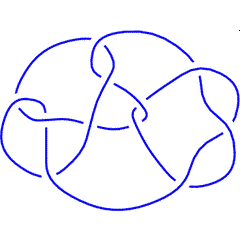An Arc Presentation  of a knot
of a knot  (in "grid form", to be precise) is a planar (toroidal, to be precise) picture of the knot in which all arcs are either horizontal or vertical, in which the vertical arcs are always "above" the horizontal arcs, and in which no two horizontal arcs have the same
(in "grid form", to be precise) is a planar (toroidal, to be precise) picture of the knot in which all arcs are either horizontal or vertical, in which the vertical arcs are always "above" the horizontal arcs, and in which no two horizontal arcs have the same  -coordinate and no two vertical arcs have the same
-coordinate and no two vertical arcs have the same  -coordinate (read more at [1]). Without loss of generality, the
-coordinate (read more at [1]). Without loss of generality, the  -coordinates of the vertical arcs in
-coordinates of the vertical arcs in  are the integers
are the integers  through
through  for some
for some  , and the
, and the  -coordinates of the horizontal arcs in
-coordinates of the horizontal arcs in  are (also!) the integers
are (also!) the integers  through
through  .
.
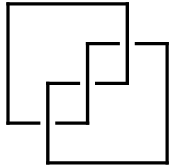
((5,2), (1,3), (2,4), (3,5), (4,1))
Thus for example, on the left is an arc presentation  of the trefoil knot. It can be represented numerically by the sequence of ordered pairs shown below it. This sequence reads: the lowest horizontal arc in
of the trefoil knot. It can be represented numerically by the sequence of ordered pairs shown below it. This sequence reads: the lowest horizontal arc in  connects the 5th vertical arc with the 2nd; the next horizontal arc in
connects the 5th vertical arc with the 2nd; the next horizontal arc in  connects the 1st vertical with the 3rd, and so on. In general, an arc presentation involving
connects the 1st vertical with the 3rd, and so on. In general, an arc presentation involving  horizontal and
horizontal and  vertical arcs will be described in this way by a sequence of
vertical arcs will be described in this way by a sequence of  ordered pairs of integers in the range between
ordered pairs of integers in the range between  and
and  .
.
Arc presentations are used extensively in the computation of Heegaard Floer Knot Homologies.
KnotTheory` knows about arc presentations:
(For In[1] see Setup)
| In[1]:=
|
?ArcPresentation
|
| ArcPresentation[{a1,b1}, {a2, b2}, ..., {an,bn}] is an arc presentation of a knot (as often used in the realm of Heegaard-Floer homologies), where the horizontal arc at row i connects column ai to column bi. ArcPresentation[K] returns an arc presentation of the knot K. ArcPresentation[K, Reduce -> r] attemps at most r reduction steps (using a naive reduction algorithm) following a naive creation of some arc presentation for K.
|
|
In[2]:=
|
ap = ArcPresentation["K11n11"]
|
Out[2]=
|
ArcPresentation[{12, 2}, {1, 10}, {3, 9}, {5, 11}, {9, 12}, {4, 8},
{2, 5}, {11, 7}, {8, 6}, {7, 4}, {10, 3}, {6, 1}]
|
In[4]:=
|
Draw[ap]
|
|
|
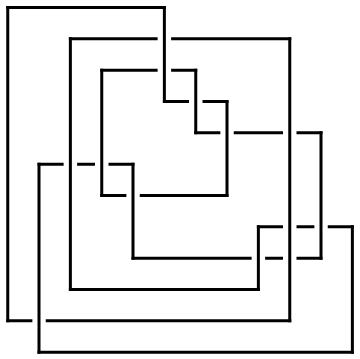
|
Out[4]=
|
-Graphics-
|
In[5]:=
|
ap0 = ArcPresentation["K11n11", Reduce -> 0]
|
Out[5]=
|
ArcPresentation[{13, 19}, {20, 23}, {19, 22}, {15, 14}, {14, 2},
{1, 13}, {3, 12}, {2, 4}, {16, 18}, {17, 15}, {8, 16}, {12, 17},
{5, 7}, {4, 6}, {7, 11}, {6, 8}, {18, 10}, {11, 9}, {10, 21},
{9, 20}, {21, 5}, {22, 3}, {23, 1}]
|
| In[6]:=
|
?Draw
|
| Draw[ap] draws the Arc Presentation ap. Draw[ap, OverlayMatrix -> M] overlays the matrix M on top of that draw.
|
|
In[8]:=
|
Draw[ap0]
|
|
|
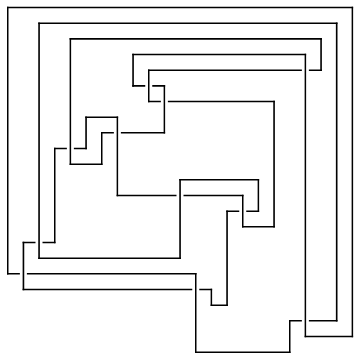
|
Out[8]=
|
-Graphics-
|
In[9]:=
|
Reflect[ap_ArcPresentation] := ArcPresentation @@ (
(Last /@ Sort[Reverse /@ Position[ap, #]]) & /@ Range[Length[ap]]
)
|
In[11]:=
|
Reflect[ap] // Draw
|
|
|
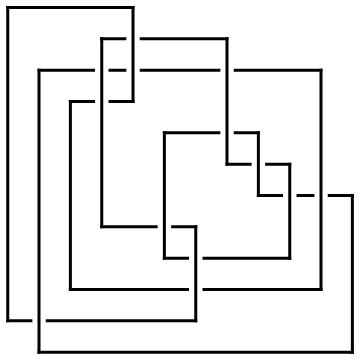
|
Out[11]=
|
-Graphics-
|
The Minesweeper Matrix  (name not generally accepted) of an arc presentation
(name not generally accepted) of an arc presentation  of
of  rows/columns is the
rows/columns is the  matrix whose
matrix whose  entry is the rotation number of
entry is the rotation number of  around a point placed between the
around a point placed between the  and
and  rows of
rows of  and between the
and between the  and
and  column of
column of  . Here's a little program to compute the minesweeper matrix of a given arc presentation, along with its output on the arc presentation of K11n11 that we have been studying above:
. Here's a little program to compute the minesweeper matrix of a given arc presentation, along with its output on the arc presentation of K11n11 that we have been studying above:
In[12]:=
|
MinesweeperMatrix[ap_ArcPresentation] := Module[
{l, CurrentRow, c1, c2, k, s},
l = Length[ap];
CurrentRow = Table[0, {l}];
Table[
{c1, c2} = Sort[ap[[k]]];
s = Sign[{-1, 1}.ap[[k]]];
Do[
CurrentRow[[c]] += s,
{c, c1, c2 - 1}
];
CurrentRow,
{k, l}
]
];
|
In[14]:=
|
Draw[ap, OverlayMatrix -> MinesweeperMatrix[ap]]
|
|
|
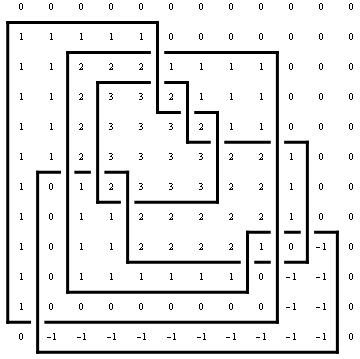
|
Out[14]=
|
-Graphics-
|
If  , it is known that the determinant of the matrix
, it is known that the determinant of the matrix  is the Alexander polynomial of the knot presented by
is the Alexander polynomial of the knot presented by  , up to signs and powers of
, up to signs and powers of  and
and  . Let us check this in our case:
. Let us check this in our case:
In[15]:=
|
{Det[t^MinesweeperMatrix[ap]], Alexander[ap][t]} // Factor
|
Out[15]=
|
11 2 2 3 4 5 6
{(-1 + t) t (1 - 5 t + 13 t - 17 t + 13 t - 5 t + t ),
2 3 4 5 6
1 - 5 t + 13 t - 17 t + 13 t - 5 t + t
-------------------------------------------}
3
t
|
